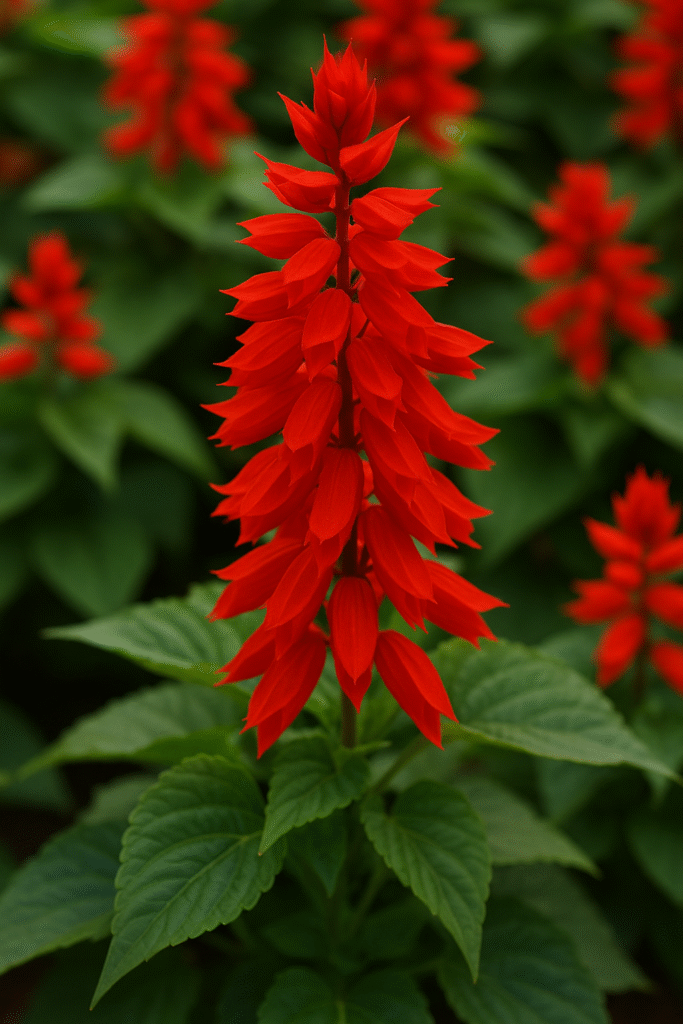If you’re searching for a flower that brings intense color, attracts pollinators, and is easy to care for, the Brazilian Salvia (Salvia splendens) is a perfect match. Native to Brazil’s tropical regions, this plant has made its way into gardens across the world thanks to its fiery red blooms and lush green foliage.
In this article, you’ll discover everything about this stunning ornamental plant—from its origins and appearance to care tips, landscaping uses, and some fascinating botanical facts.
A Tropical Origin with Striking Appearance
Salvia splendens is native to the southeast of Brazil, particularly in areas like Minas Gerais. It thrives in warm, humid climates and is commonly found in the wild as well as in cultivated gardens.
This herbaceous plant grows to a height of 12 to 28 inches (30 to 70 cm), forming dense, compact bushes. Its leaves are bright green, oval-shaped, and finely serrated. However, its main attraction is undoubtedly the flowers—tall, upright spikes composed of tubular blossoms that come in red, pink, white, purple, or even salmon tones. The red variety is the most iconic and widely grown.
Why You Should Grow Brazilian Salvia
The Brazilian Salvia offers much more than just good looks:
- Attracts Pollinators: Hummingbirds and butterflies are especially drawn to its nectar-rich flowers.
- Long Blooming Period: In warm regions, it can bloom nearly all year long.
- Adaptable: Suitable for garden beds, pots, hanging baskets, and balconies with plenty of light.
- Low Maintenance: A great option for beginner gardeners or those looking for fuss-free beauty.
Growing and Caring for Brazilian Salvia
This plant is known for being undemanding and fast-growing, as long as it’s placed in the right conditions. Here’s how to care for it:
- Sunlight: Prefers full sun but can tolerate partial shade.
- Soil: Well-drained, fertile soil with good organic matter content.
- Watering: Keep the soil slightly moist, avoiding waterlogging. In hot weather, increase watering frequency.
- Fertilization: A balanced fertilizer (like NPK 10-10-10) every two weeks helps boost flowering.
- Deadheading: Removing spent flowers promotes continuous blooming and keeps the plant compact.
Best Time to Plant
The best time to sow Salvia splendens is in late winter or early spring so that it can develop during the warmer months. In frost-free areas, it can be planted almost year-round.
Landscaping and Decorative Uses
Brazilian Salvia is a landscaper’s favorite in public gardens, parks, and home yards. It provides bold color accents and works beautifully in flower beds or as borders.
It pairs well with other annuals like petunias, marigolds, and zinnias. In containers or raised planters, it adds height, texture, and an inviting tropical look.
Botanical Curiosities
- The name “Salvia” comes from the Latin salvare, meaning “to heal,” though this particular species is ornamental, not medicinal.
- While perennial in its native climate, it’s typically grown as an annual in temperate zones.
- It’s a great choice for educational gardens, urban green projects, and schoolyards because of its ability to support biodiversity.
Is It Right for Your Garden?
If your gardening style includes vibrant color, tropical textures, and minimal effort, Brazilian Salvia is a smart and beautiful choice. Even in small spaces, it delivers big visual impact and invites life to your surroundings.
Its ease of care, combined with its appeal to wildlife, makes it ideal for eco-friendly gardeners looking to make a statement.

Bonus Tip for Efficient Gardening
Ready to make your gardening routine even more enjoyable?
Check out this 13-Piece Gardening Tool Set made of durable stainless steel, complete with a stylish carry bag—perfect for planting, pruning, and taking care of your Brazilian Salvia and other flowers.
🌿 It also makes a lovely gift for women who love gardening!

